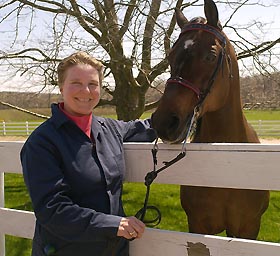|
This is an archived
article. For the latest news, go to the Advance Homepage
For more archives, go to the Advance Archive/Search Page. |
||
|
Pathobiologist Helping Develop
The experimental vaccine, made from one of the proteins in the virus, is expected to be quicker and safer than the vaccine currently on the market, which is made from whole dead virus. And because it is safer, it is more likely to be developed for humans.
Sandra Bushmich, an associate professor of pathobiology and veterinary science, has been testing the vaccine - already shown to be well tolerated by other species - on UConn horses from the Department of Animal Science. Rapid Spread The Centers for Disease Control reported more than 4,100 cases of West Nile in humans nationally last year, including 284 deaths. More than 14,700 horse cases were reported by the U.S. Department of Agriculture for 2002. One third of the horses infected either die or have to be euthanized. "West Nile has spread much more rapidly than expected," says Bushmich. In Connecticut last year, although the number of human cases was up over the previous year, the number of horse cases went down. Bushmich attributes the decrease in the number of horses reported with West Nile to the vaccine that is already available, which is widely used in the state. "I'm sure the exposure is the same," she says. Immune Response Although West Nile tends to show up in horses and people in late summer, the mosquitoes that carry it emerge earlier. Bushmich says horses need to receive the first shot by the beginning of June, and the second a couple of weeks later. The vaccine is effective for a year. L2 Diagnostics, the Yale-based incubator company, hopes to get the vaccine licensed and to market it publicly. "The virus has spread so fast," says Bushmich, "people are crying out for this vaccine." Diagnostic Test Bushmich, a veterinarian who specializes in large animals and had previously worked on Lyme Disease in horses, was invited to modify a quick diagnostic test developed for West Nile virus in chickens for use in testing horses at the Connecticut Veterinary Medical Diagnostic Laboratory. The lab is housed in the pathobiology department. Veterinarians could use the test to distinguish West Nile infection from other cases of encephalitis in horses. The symptoms of West Nile are similar to those of other forms of encephalitis, and include - in both horses and humans - behavioral change, a stiff neck, fever, and weakness, sometimes leading to coma and death. Not all people and horses that are exposed to West Nile virus develop the illness, however. Using a combination of techniques and reagents from the CDC and the USDA's National Veterinary Services Laboratory in Iowa, as well as the expertise of departmental colleagues, Bushmich worked to fine tune and implement the test for horses. It was available within a year. She says she is proud of the speed with which the test was developed. "To deal with a disease like this, we needed all the components, such as public health, wildlife, agriculture, and so on. West Nile made us realize how we needed to interact," she says. "It was pretty important that we figured that out before 9/11." Increased Surveillance "We're doing increased surveillance in the hope of picking up on emerging diseases," she adds. "Many emerging diseases that affect people and animals start as animal diseases. We're always on the lookout." Bushmich continues to be involved in diagnostic testing for the virus. The test has proved useful not only for individuals, but also as a tool to track how the disease is spreading. She is comparing blood samples from those that do fall ill from the virus with samples from those that are asymptomatic. She is also trying to distinguish between positive results caused by the vaccine and those caused by the disease, and between those infected in a previous year and those more recently infected. In addition, Bushmich and colleagues are working with officials from the Connecticut departments of Public Health, Environmental Protection, and Agriculture. "We want to help the state prepare for the spread of the disease," she says, "and know where to put its resources in terms of mosquito control and education and awareness on a town-by-town basis." |
 faculty member
in the department of pathobiology and veterinary science is working
with scientists from Yale and an incubator company to develop a new
vaccine against West Nile disease in horses that may lead to the
development of a vaccine for humans.
faculty member
in the department of pathobiology and veterinary science is working
with scientists from Yale and an incubator company to develop a new
vaccine against West Nile disease in horses that may lead to the
development of a vaccine for humans.
